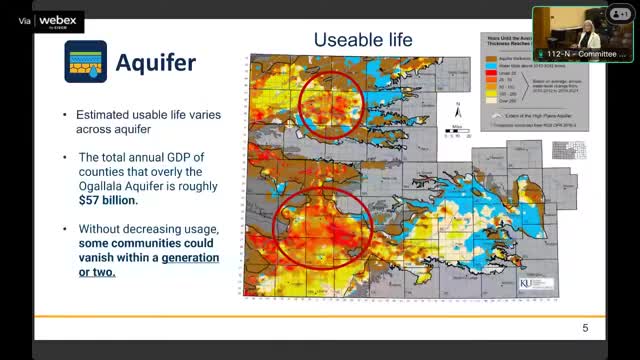Water Crisis Looms as Aquifer Access and Reservoir Management Threaten Kansas Economy
January 23, 2025 | Committee on Agriculture and Natural Resources, Standing, HOUSE OF REPRESENTATIVES, Committees, Legislative, Kansas
This article was created by AI summarizing key points discussed. AI makes mistakes, so for full details and context, please refer to the video of the full meeting. Please report any errors so we can fix them. Report an error »

In a recent meeting of the House Committee on Agriculture and Natural Resources, the pressing issues surrounding Kansas's water resources took center stage. As committee members gathered, the atmosphere was charged with urgency, reflecting the critical state of the state's aquifers and reservoirs.
One of the key discussions revolved around the uneven distribution of water resources across the state. A committee member highlighted that not all areas have equal access to aquifers, which recharge at varying rates. This disparity poses significant challenges, especially as climate patterns shift, leading to more frequent droughts and unpredictable rainfall. The member emphasized the need for a flexible and adaptive approach to managing water resources, acknowledging that both human activity and natural factors play crucial roles in water consumption and availability.
The economic implications of water scarcity were also a focal point. The towns and communities situated above these vital aquifers contribute a staggering $57 billion annually to the state's GDP. This figure underscores the interconnectedness of agriculture, community vitality, and economic prosperity. Without sufficient water, the very fabric of these communities—ranging from local businesses to essential services—could unravel, leading to broader economic consequences.
The discussion further extended to the state’s reservoirs, which serve dual purposes: flood protection and drinking water supply. With approximately two-thirds of Kansans relying on reservoirs for their drinking water, maintaining these structures is paramount. The committee member pointed out that reservoirs inevitably fill with silt over time, which can compromise their effectiveness. Preventive measures to reduce runoff and sedimentation were suggested as essential steps to ensure these water sources remain viable for future generations.
As the meeting concluded, it was clear that the challenges facing Kansas's water resources are multifaceted and urgent. The committee's discussions highlighted the need for proactive strategies to safeguard these vital assets, ensuring that both the environment and the economy can thrive in the face of changing conditions. The future of Kansas's communities and their economic health hinges on the decisions made today regarding water management.
One of the key discussions revolved around the uneven distribution of water resources across the state. A committee member highlighted that not all areas have equal access to aquifers, which recharge at varying rates. This disparity poses significant challenges, especially as climate patterns shift, leading to more frequent droughts and unpredictable rainfall. The member emphasized the need for a flexible and adaptive approach to managing water resources, acknowledging that both human activity and natural factors play crucial roles in water consumption and availability.
The economic implications of water scarcity were also a focal point. The towns and communities situated above these vital aquifers contribute a staggering $57 billion annually to the state's GDP. This figure underscores the interconnectedness of agriculture, community vitality, and economic prosperity. Without sufficient water, the very fabric of these communities—ranging from local businesses to essential services—could unravel, leading to broader economic consequences.
The discussion further extended to the state’s reservoirs, which serve dual purposes: flood protection and drinking water supply. With approximately two-thirds of Kansans relying on reservoirs for their drinking water, maintaining these structures is paramount. The committee member pointed out that reservoirs inevitably fill with silt over time, which can compromise their effectiveness. Preventive measures to reduce runoff and sedimentation were suggested as essential steps to ensure these water sources remain viable for future generations.
As the meeting concluded, it was clear that the challenges facing Kansas's water resources are multifaceted and urgent. The committee's discussions highlighted the need for proactive strategies to safeguard these vital assets, ensuring that both the environment and the economy can thrive in the face of changing conditions. The future of Kansas's communities and their economic health hinges on the decisions made today regarding water management.
View full meeting
This article is based on a recent meeting—watch the full video and explore the complete transcript for deeper insights into the discussion.
View full meeting
